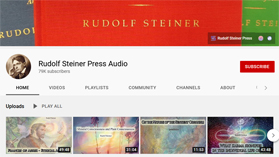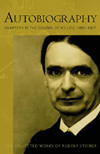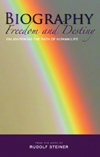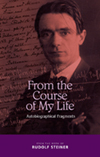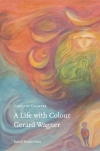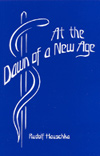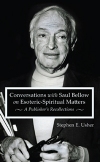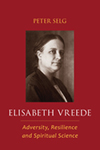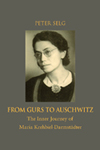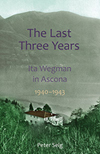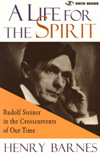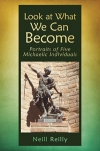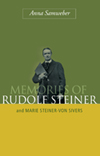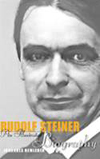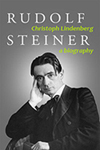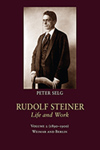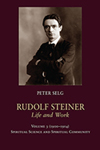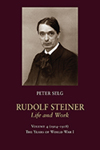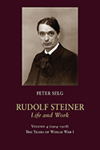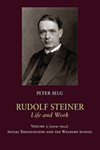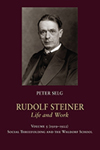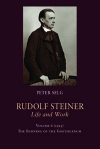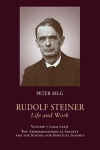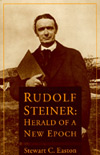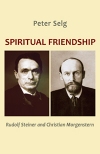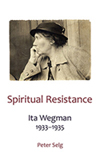
- RUDOLF STEINER
- OTHER AUTHORS
-
BIOGRAPHY, REMINISCENCESRUDOLF STEINER
Chapters in the Course of My Life: 1861-1907
Rudolf Steiner seldom spoke of himself in a personal way, but in his Autobiography we are offered a rare glimpse into some of the most intimate aspects of his inner life, his personal relationships, and significant events that helped to shape the philosopher, seer, and teacher he became.
BIOGRAPHY: FREEDOM AND DESTINY
Enlightening the Path of Human Life
The path of an individual human life - our biography - is something of a mystery. Despite the abundance of published biographies and autobiographies of celebrities and historical figures, the scientific study of human biography remains in its infancy, with little understanding of the inherent laws in the path of an individual's life. Yet as Rudolf Steiner shows here, every biography, regardless of the individual's fame, perceived importance or outer success, is ruled by archetypal influences, patterns and laws.
Autobiographical Fragments
Your favourite occupation? Pondering and musing.
Your idea of happiness? Pondering and musing.
Your most extreme aversion? Pedantry and a sense of order.
Of what are you afraid? Punctuality. -
BIOGRAPHY, REMINISCENCESOTHER AUTHORS
Gerard Wagner
Caroline Chanter
A Life with Colour is the first complete survey of Gerard Wagner’s biography and his artistic intentions, featuring dozens of illustrations and more than 120 colour plates.
CONVERSATIONS WITH SAUL BELLOW ON ESOTERIC-SPIRITUAL MATTERS
A Publisher’s Recollections
Stephen E. Usher
“The unending cycle of crises that began with the First World War has formed a kind of person, one who has lived through terrible, strange things, and in whom there is an observable shrinkage of prejudices, a casting off of disappointing ideologies, an ability to live with many kinds of madness, an immense desire for certain durable human goods—truth, for instance, or freedom, or wisdom. I don’t think I am exaggerating; there is plenty of evidence for this.... The intelligent public is...waiting to hear from art what it does not hear from theology, philosophy, social theory, and what it cannot hear from pure science. Out of the struggle...has come an immense, painful longing for a broader, more flexible, fuller, more coherent, more comprehensive account of what we human beings are, who we are, and what this life is for.” —Saul Bellow, Nobel Lecture, 1976
Adversity, Resilience, and Spiritual Science
Peter Selg
Rudolf Steiner entrusted the Esoteric Section and the Mathematics and Astronomy Section at the Goetheanum in Dornach, Switzerland, to Elisabeth Vreede (1879–1943) because of her special abilities. He commented, “Miss. Vreede is one of the people who best understand my lectures.” Elisabeth Vreede was recognized as the “esoterically educated” member of Steiner’s governing body.
The Inner Journey of Maria Krehbiel-Darmstädter
Peter Selg
Maria Krehbiel-Darmstädter (1892–1943), who was killed at Auschwitz, was a highly gifted pupil of Rudolf Steiner and a member of the Christian Community. Born into a Jewish family in Mannheim, she was deported to Gurs camp in the Pyrénées in October 1940, where she survived harsh conditions and helped many of her fellow inmates. This book offers unique testimony of an individual rooted in esoteric Christianity, who found sources of inner resistance during one of history’s darkest periods. As the portrait of a highly ethical and sorely tried woman amid catastrophic conditions, it describes her existential efforts to summon powers of concentration, meditation and dedication to others, showing how these continued to inform her outlook and actions to the very end.
Peter Selg
“As for me, I will claim for myself the freedom always to be in the place that I feel I need to be in my inmost feelings.”—Ita Wegman, August 26, 1940
Rudolf Steiner in the Crosscurrents of our Time
Henry Barnes
Henry Barnes shows how Rudolf Steiner's own biographical development mirrors the development of anthroposophy and how both of these unfold in response to the desperate needs and challenges of the times. With extensive excerpts from Steiner's own writings, this informative and inspiring volume serves as an excellent overview of Rudolf Steiner's life and work.
Portraits of Five Michaelic Individuals
Neill Reilly
Neill Reilly presents portraits, rather than biographies, of five remarkable individuals:
Fritz Koelln
John Fentress Gardner
Lee Lecraw
Marjorie Spock
William Wardand Marie Steiner-von Sivers
Anna Samweber
‘I rang the bell, the door opened, and there stood Rudolf Steiner in person. I was so taken aback that I dropped the basket which burst open and all my clothes and underclothes, together with my other belongings, were lying at the feet of the Doctor. A ball of wool got away and rolled between Dr Steiner’s feet into the long corridor. Somewhat surprised, but amused, he said: “I have never been greeted in this way.”’
An Illustrated Biography
Johannes Hemleben
Rudolf Steiner's legacy is remarkable. Around the world, thousands of initiatives have been built up around his inspiration and thought, including Steiner Waldorf schools, special education establishments, medical clinics, biodynamic farms, cultural centres, and much more. At the core of this outer work stands the scientific and spiritual path which Steiner called anthroposophy - a philosophy and method which he expounded and developed throughout his life.
Volume 1 (1861–1890): Childhood, Youth, and Study Years
Peter Selg
“This biography does not aim for completeness, but focuses on Rudolf Steiner’s being, intentions, and journey—aspects that must not be obliterated by the many events, foundations, and people involved with Anthroposophy.... It wants to convey (to quote Emil Leinhas) ‘the immense greatness and unique significance of this individuality who radiates out over the centuries.’” —Peter Selg (from the introduction)
Volume 2 (1890-1900): Weimar and Berlin
Peter Selg
“It makes no sense to stop where Goethe stood. Yet we cannot progress unless we absorb Goethe deeply and allow ourselves to be wholly inspired by the impulses he brought into the world. This cannot be achieved as quickly as people today would like this to happen. There is nothing for it; anyone who was careless enough to live at the end of the nineteenth century must bear it.” —Rudolf Steiner, July 18, 1891
Volume 3 (1900–1914) Spiritual Science and Spiritual Community
Peter Selg
“Without new impulses humanity will be overwhelmed and paralyzed—in ways we cannot even imagine today—by the domination of mere outer technology. Humanity will perish because all religious, scientific, philosophical, artistic, and—in a higher sense—ethical interests would be torn from the human soul. Without new spiritual impulses we will become living machines.” —Rudolf Steiner (CW 158)
1914–1918: The Years of World War I (Vol. 4)
Peter Selg
In volume 4, Peter Selg continues his thorough and careful exploration into Rudolf Steiner’s life and work, focusing on the period of 1914 to 1918 and World War I. Steiner experienced the assassination in Sarajevo as a deeply serious tragedy that would inevitably lead to war and lamented the widespread reluctance to regard such critical events with the appropriate earnestness and concern.
1914–1918: The Years of World War I (Vol. 4)
Peter Selg
In volume 4, Peter Selg continues his thorough and careful exploration into Rudolf Steiner’s life and work, focusing on the period of 1914 to 1918 and World War I. Steiner experienced the assassination in Sarajevo as a deeply serious tragedy that would inevitably lead to war and lamented the widespread reluctance to regard such critical events with the appropriate earnestness and concern.
1919–1922: Social Threefolding and the Waldorf School (Vol. 5)
Peter Selg
“Any dependence of the spiritual life on the economic life and on the public life must cease. The spiritual life must stand on its own ground. Then it will be able to give to the economic life and to the public life what neither of them can give to the spiritual life. This is immensely important! We can become fully human only when we work on the basis of an independent spiritual life.” —Rudolf Steiner (Polarities in the Evolution of Mankind)
1919–1922: Social Threefolding and the Waldorf School (Vol. 5)
Peter Selg
“Any dependence of the spiritual life on the economic life and on the public life must cease. The spiritual life must stand on its own ground. Then it will be able to give to the economic life and to the public life what neither of them can give to the spiritual life. This is immensely important! We can become fully human only when we work on the basis of an independent spiritual life.” —Rudolf Steiner (Polarities in the Evolution of Mankind)
Volume 6 - 1923: The Burning of the Goetheanum
Peter Selg
“Try to become one with the world—that will be the best and most important ‘program’. It is something that cannot be contained in statutes but needs to burn in our hearts as a flame.” —Rudolf Steiner
Volume 7 - 1924-1925: The Anthroposophical Society and the School for Spiritual Science
Peter Selg
In the seventh and final volume in his comprehensive biography of Rudolf Steiner, Peter Selg describes Steiner's final months on Earth. Although his health was beginning to decline, 1924 was arguably his most productive and fruitful year. It saw a new beginning for the Anthroposophical Society, as well as the beginnings of the Esoteric School and the School for Spiritual Science, both of which continue to constitute the heart of the Society's core mission in the world.
RUDOLF STEINER: HERALD OF A NEW EPOCH
Stuart C. Easton
The first full-scale biography shows the development of Steiner's thought and work and provides a context for his various books, lectures, artistic achievements and activities.
Rudolf Steiner and Christian Morgenstern
Peter Selg
“Their complete understanding of each other and those two great spirits passing into each other created an atmosphere, perceptible to all, that had bearing force and radiated hope for the future.” —Marie Steiner-von Sivers
Ita Wegman, 1933-1935
Peter Selg
From 1933 to 1935, Ita Wegman was confronted by both Nazi fascism and internal crises in the General Anthroposophical Society. During those years, she travelled to Palestine in the fall of 1934 following a grave illness that nearly ended with her death. Her correspondence during this period, as well as her notes on the trip, reveal the great biographical importance to her of these travels and indeed the whole scope of her spiritual experiences in 1934.

